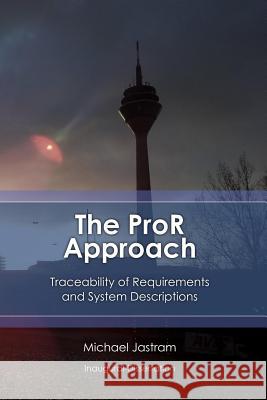The ProR Approach: Traceability of Requirements and System Descriptions: Theory and practice on using and extending the Eclipse Requireme » książka
The ProR Approach: Traceability of Requirements and System Descriptions: Theory and practice on using and extending the Eclipse Requireme
ISBN-13: 9781478220060 / Angielski / Miękka / 2012 / 206 str.
The ProR Approach: Traceability of Requirements and System Descriptions: Theory and practice on using and extending the Eclipse Requireme
ISBN-13: 9781478220060 / Angielski / Miękka / 2012 / 206 str.
(netto: 57,02 VAT: 5%)
Najniższa cena z 30 dni: 59,70
ok. 16-18 dni roboczych
Dostawa w 2026 r.
Darmowa dostawa!
Creating a system description of high quality is still a challenging problem in the field of requirements engineering. Creating a formal system description addresses some issues. However, the relationship of the formal model to the user requirements is rarely clear, or documented satisfactorily. This work presents the ProR approach, an approach for the creation of a consistent system description from an initial set of requirements. The resulting system description is a mixture of formal and informal artefacts. Formal and informal reasoning is employed to aid in the process. To achieve this, the artefacts must be connected by traces to support formal and informal reasoning, so that conclusions about the system description can be drawn. The ProR approach enables the incremental creation of the system description, alternating between modelling (both formal and informal) and validation. During this process, the necessary traceability for reasoning about the system description is established. The formal model employs refinement for further structuring of large and complex system descriptions. The development of the ProR approach is the first contribution of this work. This work also presents ProR, a tool platform for requirements engineering, that supports the ProR approach. ProR has been integrated with Rodin, a tool for Event-B modelling, to provide a number of features that allow the ProR approach to scale. The core features of ProR are independent from the ProR approach. The data model of ProR builds on the international ReqIF standard, which provides interoperability with industrial tools for requirements engineering. The development of ProR created enough interest to justify the creation of the Requirements Modeling Framework (RMF), a new Eclipse Foundation project, which is the open source host for ProR. RMF attracted an active community, and ProR development continues. The development of ProR is the second contribution of this work. This work is accompanied by a case study of a traffic light system, which demonstrates the application of both the ProR approach and ProR.
Zawartość książki może nie spełniać oczekiwań – reklamacje nie obejmują treści, która mogła nie być redakcyjnie ani merytorycznie opracowana.











